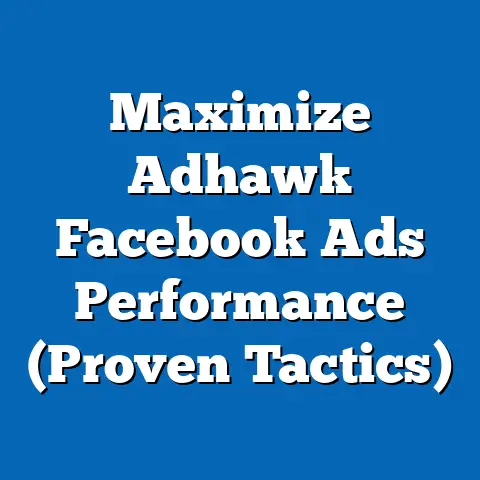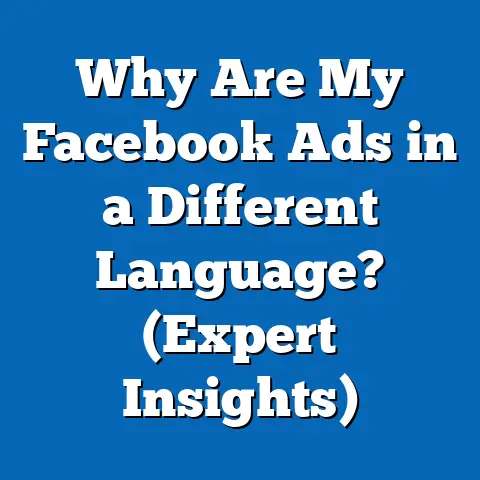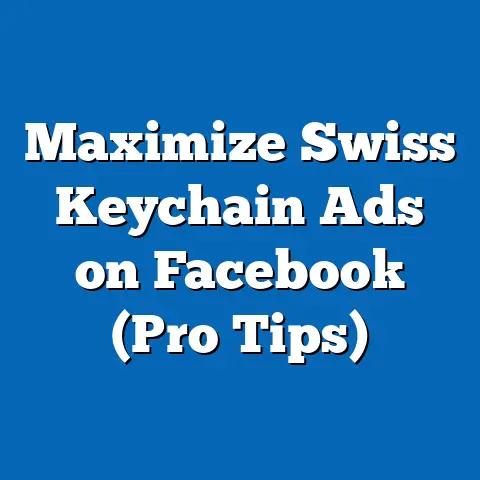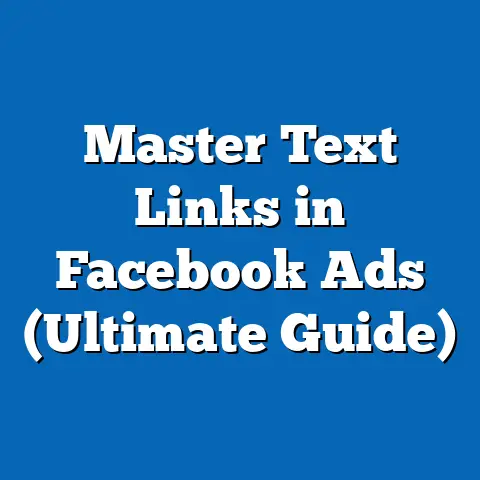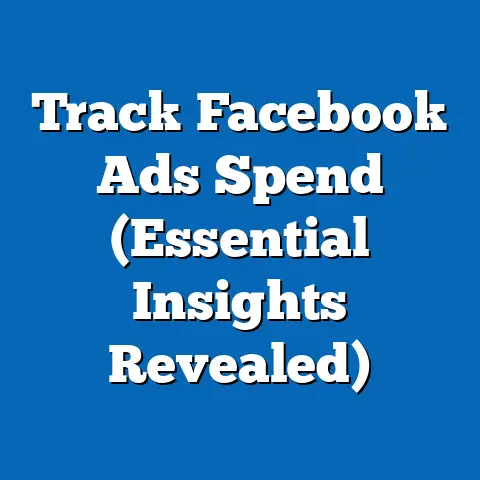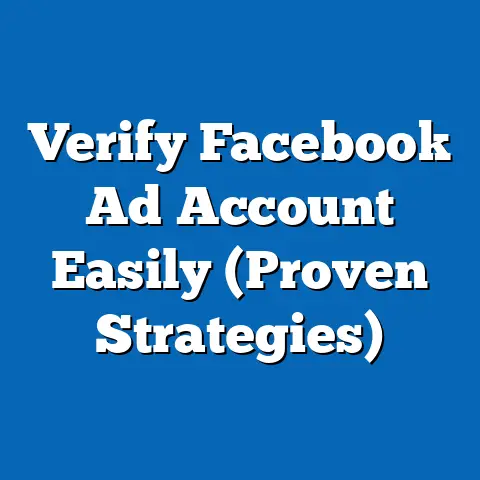Boost Webinar Attendance with Facebook Ads (Game-Changer)
In today’s fast-paced world, technology is constantly evolving, reshaping how we live, work, and communicate. The digital landscape has become the primary battleground for businesses vying for attention, and the tools and platforms we use to connect with our audiences are undergoing continuous transformation. Social media, in particular, has exploded as a force in modern marketing, offering unprecedented opportunities to engage with potential customers on a personal and interactive level.
I remember when I first started in digital marketing, the idea of targeting specific demographics with such precision seemed like something out of a science fiction movie. Now, it’s the reality we live in, and businesses that fail to adapt risk being left behind.
One of the most powerful tools in the digital marketer’s arsenal is the webinar. Think of it as a modern-day seminar, delivered directly to your audience’s screens. Webinars offer a unique opportunity to educate, engage, and convert potential customers. They allow you to showcase your expertise, build relationships, and ultimately, drive sales. However, the biggest challenge many businesses face is attracting enough attendees to make their webinars worthwhile. A poorly attended webinar can feel like shouting into the void, wasting valuable time and resources.
This is where effective marketing strategies become absolutely crucial. You can have the most insightful, engaging webinar content in the world, but if nobody shows up, it’s all for naught. The key is to reach the right audience, with the right message, at the right time. And that’s precisely where Facebook Ads come into play.
Facebook Ads are a game-changer in boosting webinar attendance, offering a level of targeting and control that traditional marketing methods simply can’t match. In this article, I’m going to delve deep into the world of Facebook Ads and show you how to leverage its power to fill your webinars with eager attendees. I’ll share practical strategies, real-world examples, and proven techniques that you can implement right away to see a significant increase in your webinar registrations and attendance rates. Get ready to unlock the potential of Facebook Ads and transform your webinar marketing efforts!
Section 1: Understanding the Webinar Landscape
Let’s start with the basics. What exactly is a webinar? At its core, a webinar is an online seminar or presentation delivered over the internet. It’s a powerful tool for sharing information, engaging with an audience, and building relationships. Webinars can take many forms, from educational workshops and product demos to Q&A sessions and panel discussions. They’re used across a wide range of industries, including education, business, healthcare, and technology.
In the education sector, webinars are often used to deliver online courses, provide training to teachers, or offer supplemental learning resources to students. In the business world, webinars are a popular way to generate leads, nurture prospects, and onboard new customers. Healthcare professionals use webinars to share the latest medical research, train staff, and educate patients. And in the tech industry, webinars are a great way to showcase new products, provide technical support, and build a community around a particular technology.
To understand the importance of effective webinar promotion, it’s crucial to look at current trends in webinar attendance. According to recent statistics, the average webinar attendance rate hovers around 40-50% of those who register. This means that for every 100 people who sign up for your webinar, only 40-50 will actually show up. This number can vary depending on a number of factors, including the topic of the webinar, the quality of the content, the speaker’s reputation, and the effectiveness of the marketing efforts.
Several factors can influence webinar attendance rates. A compelling topic that resonates with the target audience is essential. People are more likely to attend a webinar if they believe it will provide them with valuable information or help them solve a problem. The quality of the content and the speaker’s expertise also play a significant role. If the webinar is poorly organized or the speaker is unengaging, attendees are likely to drop off.
The timing of the webinar is also crucial. Choose a time that is convenient for your target audience, taking into account their time zone and work schedule. Finally, effective marketing and promotion are essential for driving registrations and encouraging attendees to show up. Sending reminder emails, promoting the webinar on social media, and offering incentives for attendance can all help boost attendance rates.
Low webinar attendance can have significant implications for business goals. If you’re using webinars to generate leads, low attendance means fewer potential customers to engage with. If you’re using webinars to train customers, low attendance means fewer people are receiving the training they need to effectively use your product or service. And if you’re using webinars to build brand awareness, low attendance means you’re missing out on opportunities to reach a wider audience.
That’s why targeted marketing is so important. It’s not enough to simply promote your webinar to anyone and everyone. You need to reach the right audience – the people who are most likely to be interested in your topic and benefit from attending. And that’s where Facebook Ads can make a huge difference.
Key Takeaway: Webinars are a powerful tool for education, engagement, and conversion, but low attendance rates can hinder business goals. Targeted marketing is crucial for reaching the right audience and maximizing webinar attendance.
Section 2: The Power of Facebook Ads
Facebook is no longer just a social network; it’s a marketing powerhouse. With billions of active users worldwide, Facebook offers businesses an unparalleled opportunity to reach a massive audience with targeted advertising.
As of [Insert current year] Facebook boasts over [Insert current statistic] monthly active users, making it the most popular social media platform in the world. These users span a wide range of demographics, interests, and behaviors, making Facebook a highly versatile platform for reaching diverse audiences. What I’ve found particularly useful is the ability to pinpoint specific interests and behaviors, allowing me to tailor my message to the people most likely to be interested in my offer.
But it’s not just the size of the audience that makes Facebook so attractive to marketers. It’s also the level of engagement. Facebook users spend an average of [Insert current statistic] minutes per day on the platform, browsing news feeds, watching videos, and interacting with friends and family. This high level of engagement provides businesses with ample opportunities to capture users’ attention and drive conversions.
Compared to traditional marketing methods like print advertising or television commercials, Facebook Ads offer several key advantages for promoting webinars. First and foremost, Facebook Ads are highly targeted. You can target your ads based on demographics, interests, behaviors, and even custom audiences. This allows you to reach the people who are most likely to be interested in your webinar, rather than wasting your advertising budget on people who are not.
Second, Facebook Ads are highly flexible. You can choose from a variety of ad formats, including image ads, video ads, carousel ads, and lead ads. This allows you to create ads that are visually appealing and engaging, and that effectively communicate the value of your webinar.
Third, Facebook Ads are highly measurable. You can track the performance of your ads in real-time, monitoring metrics like impressions, clicks, conversions, and cost per conversion. This allows you to optimize your ads and improve your results over time.
I’ve seen firsthand the power of Facebook Ads in driving webinar attendance. One of my clients, a small business that provides online courses in digital marketing, was struggling to attract attendees to their webinars. They had tried promoting their webinars through email marketing and social media, but their attendance rates were consistently low.
I suggested they try using Facebook Ads to target people who were interested in digital marketing. We created a series of compelling ads that highlighted the benefits of attending their webinars, and we targeted them to specific demographics and interests. The results were dramatic. Their webinar attendance rates increased by over 300%, and they generated a significant number of new leads.
Key Takeaway: Facebook Ads offer a powerful and versatile platform for promoting webinars, with highly targeted advertising, flexible ad formats, and measurable results. Case studies demonstrate the effectiveness of Facebook Ads in driving webinar attendance.
Section 3: Crafting Compelling Facebook Ads for Webinars
Creating effective Facebook Ads for webinars requires a strategic approach, focusing on several key components. A successful Facebook ad typically includes compelling copy, eye-catching visuals, and a strong call-to-action. These elements work together to capture the attention of your target audience and persuade them to register for your webinar.
The copy in your Facebook ad should be clear, concise, and engaging. It should clearly communicate the value of your webinar and highlight the benefits of attending. Use strong headlines and bullet points to draw attention to the key points. And be sure to include a sense of urgency to encourage people to register now.
The visuals in your Facebook ad should be eye-catching and relevant to your webinar topic. Use high-quality images or videos that capture the attention of your target audience. And be sure to include your brand logo and colors to reinforce your brand identity.
The call-to-action in your Facebook ad should be clear and direct. Tell people exactly what you want them to do, such as “Register Now,” “Sign Up Today,” or “Learn More.” Make it easy for people to register for your webinar by including a direct link to your registration page.
When creating ad content specifically tailored for webinar promotion, there are a few best practices to keep in mind. First, focus on the benefits of attending the webinar. What will attendees learn? How will it help them solve a problem or achieve a goal?
Second, highlight the speaker’s expertise and credibility. Why should people listen to this speaker? What qualifications or experience do they have that make them an authority on the topic?
Third, create a sense of exclusivity. Make people feel like they’re missing out if they don’t attend the webinar. Offer limited-time bonuses or discounts for early registration.
Fourth, use social proof. If you have testimonials from past attendees, include them in your ad copy. This will help build trust and credibility with potential attendees.
Let’s look at some examples of effective ad copy and design elements that have proven successful in driving webinar registrations.
Example 1: Benefit-Driven Copy
Headline: Learn the Secrets to Doubling Your Email List in 30 Days!
Body: In this free webinar, you’ll discover proven strategies to grow your email list, generate more leads, and boost your sales. Limited seats available. Register now!
Visual: Image of a growing graph with email icons.
Example 2: Expertise-Focused Copy
Headline: Expert Marketer Reveals His Top Lead Generation Secrets!
Body: Join John Smith, a renowned marketing expert, as he shares his proven strategies for generating high-quality leads. This webinar is a must-attend for any marketer looking to boost their lead generation efforts. Register now!
Visual: Professional headshot of John Smith.
Example 3: Urgency-Driven Copy
Headline: Last Chance to Register for Our Free Webinar on Social Media Marketing!
Body: Don’t miss out on this opportunity to learn the latest social media marketing strategies. This webinar is happening tomorrow, and seats are filling up fast. Register now before it’s too late!
Visual: Image of a countdown timer.
Key Takeaway: Compelling Facebook Ads for webinars require a strategic combination of engaging copy, eye-catching visuals, and a strong call-to-action. Focus on the benefits of attending, highlight the speaker’s expertise, create a sense of exclusivity, and use social proof to drive registrations.
Section 4: Targeting Your Audience Effectively
Audience targeting is the cornerstone of successful Facebook Ads. It’s the process of identifying and reaching the specific group of people who are most likely to be interested in your webinar. By targeting your ads effectively, you can significantly increase your webinar attendance and generate more leads.
Facebook offers a wide range of targeting options, allowing you to reach your ideal audience based on demographics, interests, behaviors, and custom audiences.
Demographic targeting allows you to target people based on their age, gender, location, education, and other demographic characteristics. This is useful for reaching specific segments of the population who are more likely to be interested in your webinar. For example, if you’re hosting a webinar on retirement planning, you might target people who are over the age of 50.
Interest targeting allows you to target people based on their interests, hobbies, and activities. This is useful for reaching people who are passionate about a particular topic or industry. For example, if you’re hosting a webinar on digital marketing, you might target people who are interested in social media, SEO, or content marketing.
Behavior targeting allows you to target people based on their online behavior, such as their purchase history, website visits, and app usage. This is useful for reaching people who have demonstrated an interest in your products or services. For example, if you’re hosting a webinar on e-commerce, you might target people who have recently purchased products online.
Custom audiences allow you to target people based on your own data, such as your email list, website visitors, or app users. This is useful for retargeting people who have already shown an interest in your business. For example, you might create a custom audience of people who have visited your website’s webinar registration page but haven’t yet registered.
To create audience segments that align with your webinar’s topic and objectives, start by defining your ideal attendee. What are their demographics? What are their interests? What are their behaviors? Once you have a clear picture of your ideal attendee, you can use Facebook’s targeting options to reach them.
For example, if you’re hosting a webinar on “How to Start a Successful Blog,” you might create an audience segment that includes people who are:
- Demographics: Age 25-45, located in the United States, interested in entrepreneurship.
- Interests: Blogging, content marketing, social media marketing.
- Behaviors: Have visited websites related to blogging or online business.
Facebook Pixel data is incredibly valuable for retargeting and optimizing ad performance. The Facebook Pixel is a small piece of code that you can install on your website to track user behavior. This data can be used to create custom audiences of people who have visited your website, viewed specific pages, or completed specific actions.
For example, you can use Facebook Pixel data to create a custom audience of people who have visited your webinar registration page but haven’t yet registered. You can then retarget these people with ads that encourage them to register. You can also use Facebook Pixel data to optimize your ad performance by tracking which ads are driving the most conversions and adjusting your targeting accordingly.
I’ve found that retargeting with the Facebook Pixel is one of the most effective ways to boost webinar attendance. By showing ads to people who have already expressed an interest in your webinar, you can significantly increase your chances of getting them to register.
Key Takeaway: Effective audience targeting is crucial for maximizing webinar attendance. Utilize Facebook’s demographic, interest, behavior, and custom audience targeting options to reach your ideal attendee. Leverage Facebook Pixel data for retargeting and optimizing ad performance.
Section 5: Budgeting and Ad Placement Strategies
The financial aspect of running Facebook Ads is a critical consideration, especially for webinar promotion. Effective budgeting strategies and ad placement choices can significantly impact your return on investment (ROI).
When it comes to budgeting, it’s important to determine how much you’re willing to spend to acquire a single webinar registrant. This is known as your cost per acquisition (CPA). To calculate your CPA, you’ll need to estimate your conversion rate – the percentage of people who click on your ad and then register for your webinar.
For example, if you estimate that 5% of people who click on your ad will register for your webinar, and you’re willing to spend $5 per registrant, then you should set your cost per click (CPC) at $0.25. ($5 / 20 clicks = $0.25 per click).
There are two main budgeting strategies you can use on Facebook: daily budget and lifetime budget. A daily budget allows you to set a fixed amount that you’re willing to spend each day. A lifetime budget allows you to set a total amount that you’re willing to spend over the entire duration of your ad campaign.
The best strategy for you will depend on your specific goals and circumstances. If you’re running a short-term campaign, such as promoting a webinar that’s happening in a week, a lifetime budget may be the best option. If you’re running a long-term campaign, such as promoting a series of webinars over several months, a daily budget may be more appropriate.
Facebook offers a variety of ad placement options, including the news feed, stories, Instagram, and the Audience Network. Each placement has its own advantages and disadvantages, and the best choice for you will depend on your target audience and your ad creative.
The news feed is the most popular ad placement on Facebook, and it’s a good choice for reaching a wide audience. However, it can also be more expensive than other placements.
Stories are a more visual and engaging ad placement, and they’re a good choice for reaching younger audiences. However, stories ads are typically shorter and less informative than news feed ads.
Instagram is a popular ad placement for reaching a younger, more visually oriented audience. However, Instagram ads are typically more expensive than Facebook ads.
The Audience Network allows you to show your ads on websites and apps outside of Facebook. This is a good choice for reaching a wider audience and driving more traffic to your website. However, the quality of traffic from the Audience Network can be lower than the quality of traffic from Facebook.
A/B testing is a powerful technique for refining ad placements and improving results over time. A/B testing involves creating two or more versions of your ad and showing them to different segments of your audience. By tracking the performance of each version, you can identify which one is most effective and use that information to optimize your ad campaign.
For example, you might A/B test different ad placements to see which one drives the most webinar registrations. Or you might A/B test different ad creative to see which one generates the highest click-through rate.
Key Takeaway: Effective budgeting and ad placement strategies are crucial for maximizing your ROI on Facebook Ads. Determine your cost per acquisition, choose the right budgeting strategy, and A/B test different ad placements to optimize your results.
Section 6: Measuring Success and Analyzing Results
Tracking and analyzing the performance of your Facebook Ads is essential for optimizing your campaigns and maximizing your webinar attendance. By monitoring key metrics and interpreting the data, you can identify what’s working and what’s not, and make informed decisions about how to improve your results.
There are several key metrics to monitor when tracking the performance of your Facebook Ads for webinar promotion.
- Impressions: The number of times your ad was shown to people.
- Reach: The number of unique people who saw your ad.
- Click-Through Rate (CTR): The percentage of people who saw your ad and clicked on it.
- Conversion Rate: The percentage of people who clicked on your ad and then registered for your webinar.
- Cost Per Click (CPC): The average cost you paid each time someone clicked on your ad.
- Cost Per Acquisition (CPA): The average cost you paid for each webinar registrant.
Facebook Ads Manager is a powerful tool for reporting and analysis. It allows you to track the performance of your ads in real-time, monitor key metrics, and generate reports that provide insights into your campaign’s effectiveness.
To use Facebook Ads Manager for reporting and analysis, start by selecting the date range you want to analyze. Then, choose the metrics you want to track. You can also segment your data by demographics, interests, and other factors to gain a deeper understanding of your audience.
Once you’ve collected your data, it’s time to interpret it and use it to inform future campaigns. Look for trends and patterns in your data. Which ads are performing well? Which ads are not? Which audiences are most responsive to your ads?
Use this information to make adjustments to your ad campaigns. Optimize your targeting, refine your ad creative, and adjust your bidding strategy to improve your results.
For example, if you notice that your CTR is low, you might try creating new ad creative with more compelling copy and visuals. If you notice that your CPA is high, you might try optimizing your targeting or adjusting your bidding strategy.
Key Takeaway: Tracking and analyzing the performance of your Facebook Ads is essential for optimizing your campaigns and maximizing your webinar attendance. Monitor key metrics, use Facebook Ads Manager for reporting and analysis, and interpret the data to inform future campaigns.
Conclusion
In this article, I’ve explored the power of Facebook Ads in boosting webinar attendance. From understanding the webinar landscape to crafting compelling ads, targeting your audience effectively, and measuring your success, I’ve covered the key strategies you need to succeed.
The rapid advancements in technology have transformed the way businesses communicate and engage with their audiences. Webinars offer a unique opportunity to connect with potential customers, build relationships, and drive sales. And Facebook Ads provide a powerful and versatile platform for promoting webinars to a targeted audience.
I encourage you to embrace the power of Facebook Ads as a strategic tool for your webinar marketing efforts. By implementing the strategies I’ve outlined in this article, you can significantly increase your webinar attendance, generate more leads, and achieve your business goals.
The future of digital marketing is constantly evolving, and it’s essential to stay ahead of the curve by adapting to technological advancements. Facebook Ads are a game-changer in the world of webinar marketing, and I encourage you to explore their potential and use them to transform your webinar marketing efforts.
Remember, the key to success with Facebook Ads is to be strategic, creative, and data-driven. By understanding your audience, crafting compelling ads, and tracking your results, you can unlock the power of Facebook Ads and achieve remarkable results. The digital landscape is vast and ever-changing, but with the right tools and strategies, you can navigate it successfully and achieve your business goals. So, go out there, create some amazing ads, and fill your webinars with eager attendees!

